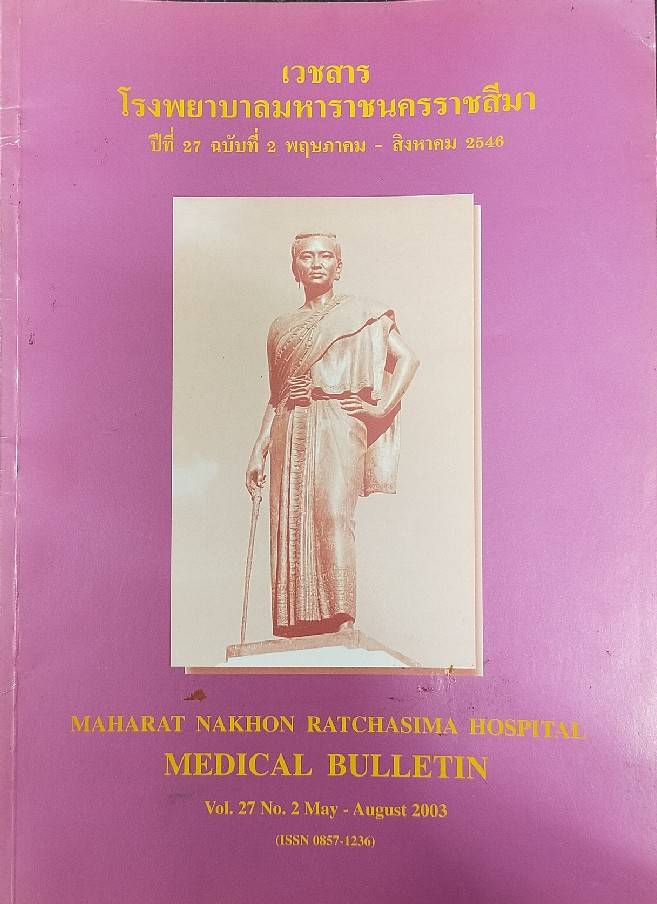100 รายแรกในการทำบัลลูนขยายหลอดเลือดหัวใจ ในโรงพยาบาลมหาราชนครราชสีมา ประสบการณ์ส่วนตัว
Main Article Content
บทคัดย่อ
ระหว่างเดือน มิถุนายน 2543 ถึง เมษายน 2545 ผู้ป่วยหลอดเลือดหัวใจตีบ 100 รายได้รับการรักษาโดยการทำบัลลูนขยายหลอดเลือดหัวใจ ที่โรงพยาบาลมหาราชนครราชสีมา ร้อยละ 75 ของผู้ป่วยเป็นชาย อายุเฉลี่ย 62.2 ± 9.3 ปีและมี ejection fraction เท่ากับ 63 ± 19.5 เปอร์เซ็นต์ ข้อบ่งชี้ในการทำบัลลูนขยายหลอดเลือดหัวใจตีบคือ stable angina (ร้อยละ 67), unstable angina (ร้อยละ 31), acute myocardial infarction (ร้อยละ 2) ผู้ป่วย 4 รายได้รับการทำบัลลูนแบบฉุกเฉินโดยที่ 1 รายมีภาวะช็อกจากหัวใจร่วมด้วย ร้อยละ 58 ของผู้ป่วยมีเส้นเลือดหัวใจตีบ 1 เส้น, ร้อยละ 35 มีเส้นเลือดหัวใจตีบ 2 เส้น และร้อยละ 7 มีเส้นเลือดหัวใจตีบ 3 เส้น บัลลูนถูกใช้ในการขยายเส้นเลือดแดง Left anterior descending ร้อยละ 51.1, เส้นเลือดแดง Right coronary 16, เส้นเลือดแดง Left circumflex ร้อยละ 30.8 และเส้นเลือดแดง Left main ร้อยละ 1.92 ค่าเฉลี่ยขนาดของบัลลูนที่ใช้ 2.5 มิลลิเมตร, อัตราการทำบัลลูนสำเร็จ (เหลือการตีบแคบของเส้นเลือดที่ทำบัลลูนน้อยกว่า 50 เปอร์เซ็นต์) เท่ากับ ร้อยละ 95 บางรายมีการใส่ขดลวดขยายเส้นเลือดร่วมด้วย 140 อัน โดยค่าเฉลี่ยขนาดขดลวดขยายเส้นเลือดเท่ากับ 2.95 มิลลิเมตร ภาวะแทรกซ้อนของการทำบัลลูนพบ 6 ราย คิดเป็นร้อยละ 6 ซึ่ง1 ราย (ร้อยละ1) เกิดการอุดตันของเส้นเลือดทันจำเป็นต้องได้รับการผ่าตัดต่อเส้นเลือดอย่างเร่งด่วน 1 ราย (ร้อยละ 1) เกิดการอุดตันของขดลวดขยายเส้นเลือดทันที สองราย (ร้อยละ 2) เกิดก้อนเลือดใหญ่ที่ขาหนีบและหนึ่งรายเสียชีวิตจากก้อนเลือดอุตดตันเส้นเลือด Left main
สรุป การทำบัลลูนขยายหลอดเลือดหัวใจสามารถทำได้ในโรงพยาบาลมหาราชนครราชสีมา โดยประสบความ สำเร็จในอัตราที่สูงและมีภาวะแทรกซ้อนต่ำ
Article Details

อนุญาตภายใต้เงื่อนไข Creative Commons Attribution-NonCommercial-NoDerivatives 4.0 International License.
เอกสารอ้างอิง
Gruntzig A, Hirzel H. Goebel N, Gattiker r, Turina M, Myler R, et al. Perkutane transluminale dilation of chronic coronary stenoses. Schweiz med Wpchenschr 1978; 108:1721-3.
King SB. Angioplasty from bench to bedside to bench. Circulation 1996;93:1621-1629.
Gruntzig A. Transluminal dilatation of coronary artery stenoses (letter). Lancet 1978; 1: 263.
Gruntzig A, Senning A, Siegenthaler WE. Non-operative dilatation of coronary artery stenosis: percutaneous transluminal angioplasty. N Engi J Med 1979: 301: 61-8.
Parisi AF, Folland ED, Hartigan P. A comparison of angioplasty medical therapy in the treatment of single vessel coronary artery disease (Veterans affairs ACMD Investigator). N Engl J Med 1992; 326: 10-6.
Dekugibyk U, Vandermael MG, Kern MJ. Coronary angioplasty: A therapeutic option for asymptomatic patients with two and three vessel coronary artery disease. J Am Coll Cardiol 1988; 11: 1173-9.
O'Keefe JH Jr, Rutherford BD,Mc Conahay DR, Johnson WL Jr,Giorgi LV, Ligon RW, et al. Multivessel coronary angioplasty from 1980 to 1989: Procedural results and long - term outcome. J Am Coll Cardiol 1990; 16: 1097-102.
Topol EJ, Leya F Pinkerton CA, Whitlow PL, Hofling B, Simonton CA, et al. A comparison of directional athrectomy with coronary angioplasty in patients with coronary artery disease: the CAVEAT Study Group. N EngI Med 1993; 329: 221-7.
Bertrand ME, Lablanche JM, Leroy F, Bauters C, De Jaegere P, Serruys PW, et al. Percutaneous transluminal coronary rotary ablation with Ratablator (European experience). Am J Cardiol 1992; 9: 470-4.
Popma JJ, Loen MB, Mintz GS, Kent KM, Salter LF, Garrand TJ, et al. Results of coronary angioplasty using the transluminal extraction cathetor. Am J Cardiol 1992; 70: 1526-32.
Ghazzal ZM, Hearn JA, Litvack F, Goldenberg T, Kent KM, Eigler N, etal. Morpbological predictors of acute complications after percutaneouse excimer lasercoronary angiographic analysis : importance of the coccentricity index. Circulation 1992; 86: 820-7.
Holmes DR Jr, Vlietstra RE, Smith HC, Vetrovec GW, Kent KM, Cowley MJ, et al. Restenosis after percutaneous transluminal coronary angioplasty (PTCA): a report from the PTCA Registry of the National Heart, Lung, and Bolld Institute. Am J Cardiol 1984; 53: 77c-81c.
Gruentzig AR, King SB, Schlumpf M, Siegenthaler W. Long-term follow-up after percutaneous transluminal coronary angioplasty : the early Zurich experience. N Engl J Med 1987; 316: 1127-32.
Nobuyoshi M, Kimura T, Nosaka H, Mioka S, Ueno K, Yokoi H, et al. Restenosis after successful percutaneous transluminal coronary angioplasty : serial angiographic follow-up of 229 patients. J Am Coll Cardiol 1988;12: 616-23.
Hirshfeld JW Jr, Schwartz JS, Jugor R, MacDonale RG, Goldberg S, Savage MP, et al. Restenosis after coronary angioplasty : a multivariate statistical model to relate lesion and procedure variables to restenosis. I Am Coll Cardiol 1991;18:647-56.
Morice MC, Serruys PW, Sousa JE, Fajadet J, Ban Hayashi E, Perin M, et al. A randomized comparison of a sirolimus-eluting stent with a standard stent for coronary revascularization. N Engl J Med 2002; 346:1773-80.
Fischman DL, Leon MB, Baim DS, Schatz RA, Savage MP, Penn I, et al. A randomized comparison of coronarystent placement and balloon angioplasty in the treatment of coronary artery disease. N Eng! I Med 1994; 331: 496-501.
Serruy P, Jargerc P, Kiemeneij F, Macaya C, Rutsch W, Heyndrickx G, et al. A comparison of balloon-expandablestent implantation with balloon angioplasty in patients with coronary artery disease. NEngl I Med 1994; 331: 489-95.
Serruys PW, Emanuelsson H, Giessen W, Lunn AC,Kiemeney F, Macaya C, et al. Heparin-coated Palmazschatz stents in human coronary arteries. Early outcome of the Benestent-I pilot study. Circulation 1996; 93: 412-22.
Versaci F, Gaspardene A, Tomai F, Crea F, Chiariello L, Gioffre PA. A comparison of coronary-artery stenting with angioplasty for isolated stenosis of the proximal left anterior descending coronary artery. N Eng! J Med 1997; 336: 817-22.
Srimahachota S, Udayachalerm M, Boonyaratavej S, Sittisuk S, Suithichaiyakul T, Chaipromprasit J, et al. Percutaneous transluminal coronary angioplasty in King Chulalongkom Memorial Hospital: a four-year experience. J Med Assoc Thai. 1998;12:1181-6.


